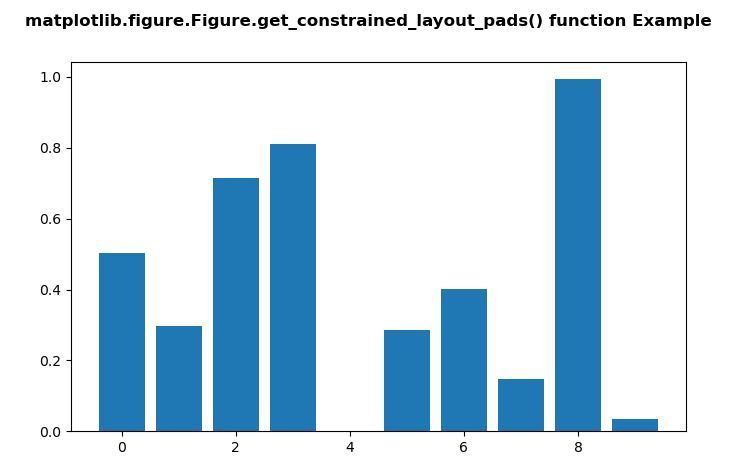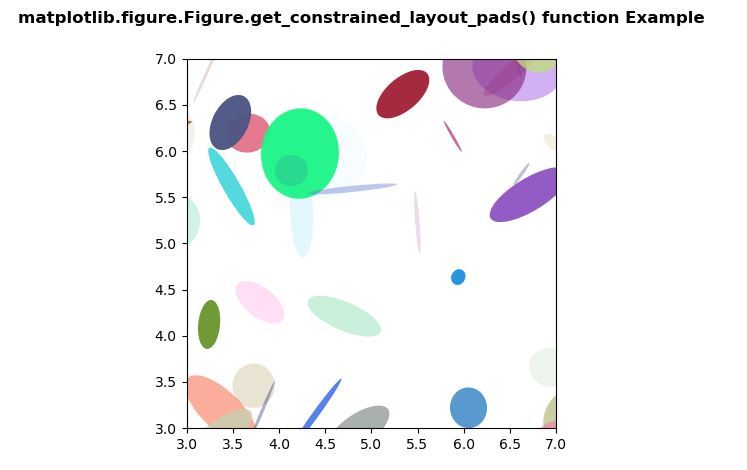Matplotlib es una biblioteca en Python y es una extensión matemática numérica para la biblioteca NumPy. El módulo de figura proporciona el artista de nivel superior, la figura, que contiene todos los elementos de la trama. Este módulo se utiliza para controlar el espaciado predeterminado de las subparcelas y el contenedor de nivel superior para todos los elementos de la parcela.
método matplotlib.figure.Figure.get_constraned_layout_pads()
El método get_constrained_layout_pads() del módulo de figura de la biblioteca matplotlib se usa para obtener el relleno para constrained_layout.
Sintaxis: get_constrained_layout_pads(self, relativo=Falso)
Parámetros: este método no acepta ningún parámetro.
Devoluciones: este método devuelve una lista de w_pad, h_pad en pulgadas y wspace y hspace como fracciones de la subparcela.
Los siguientes ejemplos ilustran la función matplotlib.figure.Figure.get_constrained_layout_pads() en matplotlib.figure:
Ejemplo 1:
# Implementation of matplotlib function
import matplotlib.pyplot as plt
from matplotlib.lines import Line2D
import numpy as np
from numpy.random import rand
fig, ax2 = plt.subplots()
ax2.bar(range(10), rand(10), picker = True)
for label in ax2.get_xticklabels():
label.set_picker(True)
def onpick1(event):
if isinstance(event.artist, Line2D):
thisline = event.artist
xdata = thisline.get_xdata()
ydata = thisline.get_ydata()
ind = event.ind
print('onpick1 line:',
np.column_stack([xdata[ind],
ydata[ind]]))
elif isinstance(event.artist, Rectangle):
patch = event.artist
print('onpick1 patch:', patch.get_path())
elif isinstance(event.artist, Text):
text = event.artist
print('onpick1 text:', text.get_text())
print("Value return by get_constrained_layout_pads() ")
w = list(fig.get_constrained_layout_pads())
print("w_pad :", w[0])
print("h_pad :", w[1])
print("wspace :", w[2])
print("hspace :", w[3])
fig.suptitle('matplotlib.figure.Figure.get_constrained_layout_pads() \
function Example\n\n', fontweight ="bold")
plt.show()
Producción:

Value return by get_constrained_layout_pads() w_pad : 0.04167 h_pad : 0.04167 wspace : 0.02 hspace : 0.02
Ejemplo 2:
# Implementation of matplotlib function
import matplotlib.pyplot as plt
import numpy as np
from matplotlib.patches import Ellipse
NUM = 200
ells = [Ellipse(xy = np.random.rand(2) * 10,
width = np.random.rand(),
height = np.random.rand(),
angle = np.random.rand() * 360)
for i in range(NUM)]
fig, ax = plt.subplots(subplot_kw ={'aspect': 'equal'})
for e in ells:
ax.add_artist(e)
e.set_clip_box(ax.bbox)
e.set_alpha(np.random.rand())
e.set_facecolor(np.random.rand(4))
ax.set_xlim(3, 7)
ax.set_ylim(3, 7)
print("Value return by get_constrained_layout_pads() ")
w = list(fig.get_constrained_layout_pads())
print("w_pad :", w[0])
print("h_pad :", w[1])
print("wspace :", w[2])
print("hspace :", w[3])
fig.suptitle('matplotlib.figure.Figure.get_constrained_layout_pads() \
function Example\n\n', fontweight ="bold")
plt.show()
Producción:

Value return by get_constrained_layout_pads() w_pad : 0.04167 h_pad : 0.04167 wspace : 0.02 hspace : 0.02
Publicación traducida automáticamente
Artículo escrito por SHUBHAMSINGH10 y traducido por Barcelona Geeks. The original can be accessed here. Licence: CCBY-SA